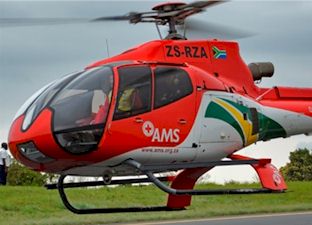

EMS Licensed companies per district (KZN) | EMS Companies per district (KZN) - total number of vehicles
KwaZulu Natal Emergency Medical Services (KZN EMS) is one of the three core functions within the Department of Health, which aims to provide a quality, efficient, professional and caring emergency medical and rescue service throughout the Province of KwaZulu-Natal. KZN EMS is a specialized 24hrs ambulance service catering for the needs of the people of KZN, from the city centers to the most rural areas. There are several functions provided by KZN EMS.
Emergency Operations is the largest section of EMS where Medical emergencies are responded to and patients are treated in the pre-hospital field before being transported to hospital for further care through the utilisation of specialised vehicles, equipment and skilled paramedics.
KZN EMS provides a rescue service which includes rescuing people who are entrapped in a motor vehicle after an accident to falling down a cliff. 4x4 rescue vehicles have been converted to carry specialised equipment, including the "jaws of life" and emergency lighting which is required to perform medical rescues. The weight and bulk of this equipment is taken into consideration when converting these vehicles.
These vehicles are not designed to transport patients but have medical equipment on board and are staffed by medical personal that have a medical and rescue qualification.
Hospitals are staffed and equipped to provide different levels of care, KZN EMS transfers patients in between hospitals depending on the patients' medical needs. There is no decrease in the level of care provided to the patients during the transfer as appropriately trained paramedics provide continued medical care during the transfer.
There are several different qualifications of medical staff who work on ambulances. This starts with:
South African advanced life support paramedics are in high demand throughout
the world due to the nature of training and skills. Training can be done either by being an ILS (with a 1000 hours of experience) and then attending a one
year training course to be a Critical care Assist or attend certain Universities
of Technology who offer the four year long Bachelor of health sciences.
Total of ALS in KZN- EMS:92
The public can access these courses directly through the private colleges, however EMS training must be provided by colleges accredited by the HPCSA.(HPCSA Accredited Emergency Care Education and Training Providers)
The control rooms play a vital function as this is where the emergencies are coordinated.
KZN EMS can be contacted by dialling 10177
Advice to people when phoning any emergency number:
This is a large component of EMS. Its main function is to transport patients, normally with chronic illnesses, who are not ill enough to require to be transported in an ambulance but who require transport for non-emergency referrals between Hospitals and from PHC Clinics to Community Health Centres and Hospitals.
These trips are planned and the patients attend prearranged appointments, after being referred to a particular clinic. The appointment letters are normally used to book places on the busses. The patients are seen as out patients at these hospitals and are transported back after their appointments.
Vehicles ranging from mini busses to large 60 seat buses are used to transport these clients. Some of the buses have had conversions done to allow for stretchers to be lifted into the bus by an hydraulic ramp. These buses are able to carry seated, wheelchair and stretcher patients.
There is basic medical equipment on board and there is medical staff other than the driver attending to and monitoring patients during the trips.

The air ambulance are aircraft which have been specially configured to be able to transport patients. EMS operates two helicopters and a fixed wing aeroplane. The function of the air ambulances is to decrease response times, provide advanced life support and decrease the time taken to travel from the accident scene to hospital. The air ambulance travels faster than automobiles and can avoid traffic and other delays, they are staffed by advanced life support paramedics.
The helicopters have the advantage of not requiring a run way to land and are therefore often used in pre hospital emergencies where patients require rapid transport to hospital. The helicopter can land on the scene and the patient loaded in and the patient is then flown to hospital for further care.
The aeroplane, unlike to helicopter requires a run way to land and is normally used to transport patients over longer distances or in special circumstances.

Due to the different functions provided by KZN EMS there is are several different types of vehicles used. These include:
The KZN EMS collage of emergency care (COEC), provides in service training for KZN EMS staff. The training ranges from routine training updates to training for intermediate life support and emergency medical technicians. Courses in medical rescue are also conducted. There are two campus’s one in Durban and the other in Pietermaritzburg. District trainers are deployed to various bases in the province to do in service training for EMS staff in those areas.
Information on Paramedic and EMS Training
This page last edited on
19 May, 2023
The materials on this website may be copied for non-commercial use as long as our copyright notice and website address are included.
Copyright 2014 - All Rights Reserved - KwaZulu-Natal Department of Health Disclaimer Website by KZN Department of Health